| Home | Nature Weekly Index |
9 August 2015 | Field Trip | Sungei Buloh Wetland Reserve |
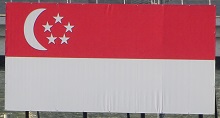 Yes, today is the 50th birthday of Singapore. Happy Birthday, Singapore!!!
Yes, today is the 50th birthday of Singapore. Happy Birthday, Singapore!!!
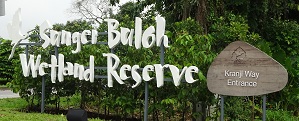 At the eve of the national day, I dropped by the new extension of the Sungei Buloh Wetland Reserve that was opened only in December
last year. I came by in October last year but this new extension was not ready then.
Although it was around 8 am when I arrived, the lighting was dim due to the hovering dark clouds. Sure enough, after just a couple
of photographs, the sky came pouring. This gave me the opportunity to visit the cafeteria (called Mangrove Kitchen) to have a cup
of coffee while waiting for the rain to go away. Fortunately, the rain did stop after 15 minutes.
At the eve of the national day, I dropped by the new extension of the Sungei Buloh Wetland Reserve that was opened only in December
last year. I came by in October last year but this new extension was not ready then.
Although it was around 8 am when I arrived, the lighting was dim due to the hovering dark clouds. Sure enough, after just a couple
of photographs, the sky came pouring. This gave me the opportunity to visit the cafeteria (called Mangrove Kitchen) to have a cup
of coffee while waiting for the rain to go away. Fortunately, the rain did stop after 15 minutes.
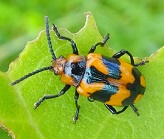
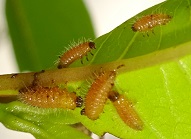 The most interesting find from this trip was the
Clerodendrum Leaf Beetle (Phyllocharis undulata). There
were many of them around the area, especially on the
Seaside Clerodendrum (Volkameria inermis) at different spots. Based on their
exclusive presence on this plant, the damage done to the leaves and the presence of the nymphs, there was no doubt that the Seaside
Clerodendrum is the host plant of this beetle. The beetle might be introduced as I had not seen it in the past in this area. The
last time that I saw adult beetles (Podontia affinis) and nymphs
in the same host plant was on a Kedongdong shrub (Spondias dulcis) in July 2012.
The spread was limited to the few shrubs and I had never seen the beetle again on other Kedongdong shrub elsewhere since then. Time
will tell whether the appearance of the Clerodendrum Leaf Beetle is also a transient phenomenon.
The most interesting find from this trip was the
Clerodendrum Leaf Beetle (Phyllocharis undulata). There
were many of them around the area, especially on the
Seaside Clerodendrum (Volkameria inermis) at different spots. Based on their
exclusive presence on this plant, the damage done to the leaves and the presence of the nymphs, there was no doubt that the Seaside
Clerodendrum is the host plant of this beetle. The beetle might be introduced as I had not seen it in the past in this area. The
last time that I saw adult beetles (Podontia affinis) and nymphs
in the same host plant was on a Kedongdong shrub (Spondias dulcis) in July 2012.
The spread was limited to the few shrubs and I had never seen the beetle again on other Kedongdong shrub elsewhere since then. Time
will tell whether the appearance of the Clerodendrum Leaf Beetle is also a transient phenomenon.
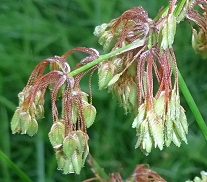
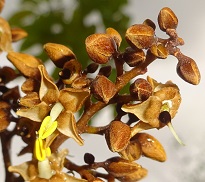 From this trip, I added 2 new plants to my website ---
Umbrella Sedge (Cyperus eragrostis) and
Pelong Tree (Pentaspadon motleyi). The 2 Pelong trees seen were cultivated and
they were young trees. However, the shorter one actually had flowers on it while the taller one had a name tag
on its trunk. I had deduced that the flowering one (with no name tag) was the same plant based on the similarity of the leaves from
the 2 trees. I tried to match the flowers through Internet search of Pentaspadon motleyi. Surprisingly, no one had posted its
flowers. The one that came close was a dried flower picture from the
Asian Plant website.
From this trip, I added 2 new plants to my website ---
Umbrella Sedge (Cyperus eragrostis) and
Pelong Tree (Pentaspadon motleyi). The 2 Pelong trees seen were cultivated and
they were young trees. However, the shorter one actually had flowers on it while the taller one had a name tag
on its trunk. I had deduced that the flowering one (with no name tag) was the same plant based on the similarity of the leaves from
the 2 trees. I tried to match the flowers through Internet search of Pentaspadon motleyi. Surprisingly, no one had posted its
flowers. The one that came close was a dried flower picture from the
Asian Plant website.
As for the lone Umbrella Sedge, it was located at the base of the shorter Pelong Tree. In wetland area like this one, sedges were all over the place and many different species looked similar to one another. This one happened to look rather different from the rest, which caught my attention. The second part of its name "eragrostis" probably indicated the similarity of its fruit (spikelet) arrangement pattern when compared to that in the grass genus Eragrostis.
It was around 11 am when I finished exploring the new extension of the Reserve. The sky was still cloudy. Since it was already closed to noon, my usual cut off time for such trip, I decided to head home and leave the exploration of the main Reserve to another day.
Update: 2 November 2015
Got a note from Yen Kheng (NPark) that the tree which I identified as Pentaspadon motleyi should be Dialium indum (Velvet Tamarind) instead. I had confused the two due to a name tag on a nearby tree and also because the leaves of both trees looked similar. Fortunately, I did get some pictures of the real Pentaspadon motleyi in another park a few weeks later.